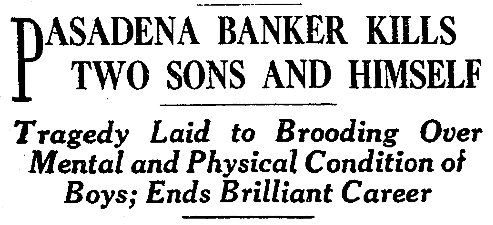
January 1, 1928
Los Angeles
A year ago prohibition agents observed that "last-minute calls for holiday cheer" skyrocketed on New Year’s Eve, so this year detective chief George Contreras and his men staked out area roadhouses. When "suspicious-looking characters" drove up, they were searched. Five flivvers were confiscated and thirty bootleggers arrested—and yet heads are splitting all over Los Angeles this morning for, despite the last minute roundup, the hooch flowed freely last night.
Indeed, by 7 o’clock this morning, the Coroner’s Office and Receiving Hospital listed two dead, eight critically—perhaps fatally—injured, and another seventy people slightly hurt in booze-fueled traffic accidents, including a pedestrian who was "partially scalped" in a hit-and-run at 39th and Vermont.
Over at 1827 W. 78th Place, Justus Gunn woke up after the party he and his wife hosted for their friends and discovered that his wife was missing. Gunn told police he "retired [or passed out?] as the guests were leaving" and didn’t notice the little woman was gone until this morning. Friends didn’t know where she was, and Gunn declared there had been "no quarrels or disagreements which might explain her sudden departure." There was no further mention of Mrs. Gunn in the pages of the Times, so whatever the cause of her disappearance, it probably wasn’t criminal.
More ominously, 14-year-old Florence Ellison left her father’s house (723 Bonnie Beach Place) yesterday afternoon to visit her mother (522 Clifton Street). Around 7:30 last night, Florence rang the doorbell at 620 South Wilton Place and told C.R. Morrison she was lost. Morrison drove Florence to the streetcar, gave her directions, then returned home and called Florence’s mother. But Florence never arrived.
Epilogue: Florence Ellison was found, fatigued and possibly drugged, on January 2. She told police that after becoming lost, she joined the New Year’s celebrations downtown where she met cabdriver Edmund D. Kearney at about midnight. They had drinks, and after a drive through Chinatown, Florence spent the night at his apartment. Kearney was held on suspicion of contributing to the delinquency of a minor. No information was given as to just how Florence spent New Year’s Day.








 Oh dear, here’s
Oh dear, here’s  And oh my, it seems one of my favorite attractions of the stage, Sidney Barnes the Human Ostrich, has expired in New Orleans. After complaining of stomach pains, the Homo Struthio underwent an operation to remove a cigar box full of bolts, carpet tacks, razor blades, washers and nails from therein—Barnes did not emerge alive. Guess
And oh my, it seems one of my favorite attractions of the stage, Sidney Barnes the Human Ostrich, has expired in New Orleans. After complaining of stomach pains, the Homo Struthio underwent an operation to remove a cigar box full of bolts, carpet tacks, razor blades, washers and nails from therein—Barnes did not emerge alive. Guess 




















 December 16, 1927
December 16, 1927






 December 8, 1927
December 8, 1927 They walked and talked along the shady paths and across sun-dappled lawns until they came to the tennis court in the rear. It was 12:15 when father pulled out and brought a pistol to his son’s temple and fired. He was then seen sliding the barrel into his mouth and pulling the trigger, his body crumpling directly next to his son’s.
They walked and talked along the shady paths and across sun-dappled lawns until they came to the tennis court in the rear. It was 12:15 when father pulled out and brought a pistol to his son’s temple and fired. He was then seen sliding the barrel into his mouth and pulling the trigger, his body crumpling directly next to his son’s. Mrs. Margaret Pumphrey, 27, of the
Mrs. Margaret Pumphrey, 27, of the 

